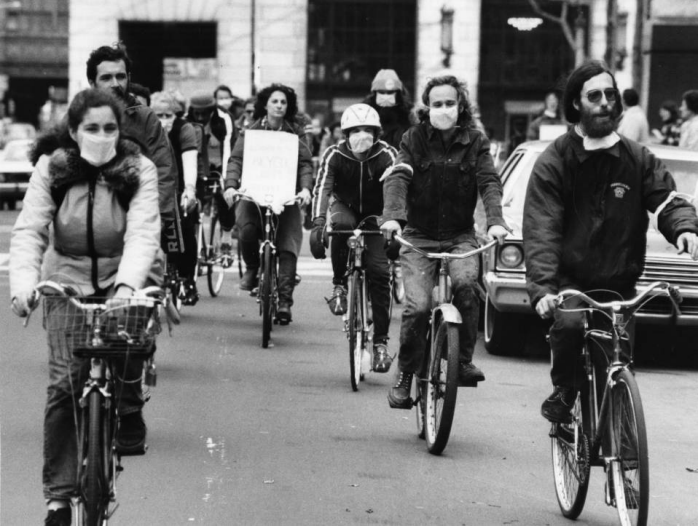
Image via Temple University archives of Evening Bulletin newspaper.
In 1972, John Dowlin, Bob Thomas, Ralph Hirsch and Gihon Jordan began meeting on the second Monday of each month in the back room of J. Mulligan’s Restaurant and Bar at 30th Street Station in Philadelphia. All avid cyclists, these guys’ conversations mostly focused on how to make Philadelphia a better city for cyclists. Some of their goals: more bicyclist access on our streets, trails and bridges.
And within a year, they found their first fight: Bicyclists should be allowed on the Ben Franklin Bridge walkway. In the 70s, there was no bike access on the bridge. It was the first of many chances for activism from the newly-formed Philadelphia Bicycle Coalition.
Throughout Our 2017 March Member Drive, we will be highlighting the Bicycle Coalition’s 45-year history to help our supporters better understand where we came from—and how much further our advocacy has to go. And hey, every week of our March Member Drive, we will offer a gift to new members and current members giving donations.
This week, in honor of our original members conceiving our organization over beers in 30th Street Station, we’re offering the official Bicycle Coalition of Greater Philadelphia bottle openers—made with actual bike chains!
But bicycles—not just beers—brought the group together, and Dowlin, Hirsch, Jordan, Bob Thomas and others, quickly got to work on access the Ben Franklin Bridge by bike.
The group and other volunteers contacted the Delaware River Port Authority and began talking to them about allowing bikes on the Ben Franklin Bridge.
And by 1973, the group made it happen. People on bicycles were allowed on the Ben Franklin Bridge again, after a ban was instituted in the 1950s. It was the first victory of the newly-formed group, but not the last—and, unfortunately, not the last time we had to fight for access to the Ben Franklin Bridge.
Four years later, it was time to hit the streets. Philadelphia’s Chestnut Street in Center City was a transit-way back then. During the day, only buses were allowed on Chestnut Street—no cars, and no bikes. The Coalition, who would soon change their name to the Bicycle Coalition of the Delaware Valley, fought back against the City of Philadelphia to allow for bikes on Chestnut Street.
And they eventually got to the point where cyclists were not officially “allowed” on the street; the law was not changed but an unofficial policy to not enforce the law on cyclists who were riding safely on the street. At the time, that was a win. Bicyclists also got together at City Hall, asking the city to better encourage bicycle commuting in the city.

Image via Temple.edu via The Evening Bulletin archives.
Later in 1977, the Coalition published their first city bicycle map.
Dowlin and Thomas are still in the Philadelphia area, and Dowlin recently met and spoke with Philadelphia Eagle (and avid cyclist) Connor Barwin to talk about the history of the Coalition for a project.

Philadelphia Eagles’ defensive end Connor Barwin with BCGP founder John Dowlin
“It was a true pleasure meeting John and talking about the early days of the Coalition,” noted Barwin of meeting with Dowlin. “My favorite part of the conversation was when John started actually advocating for more three wheeled bicycles to me. I quickly realized John hasn’t changed much the last 40 years—except nowadays he rides a tricycle inside of a bicycle.”
Of course, there were no bike lanes on city streets at that point in city history. The Coalition would soon begin that fight, too.
Stay tuned next week for information on the continued advocacy of the Bicycle Coalition of Greater Philadelphia in the 1980s, and a new gift for donating.

